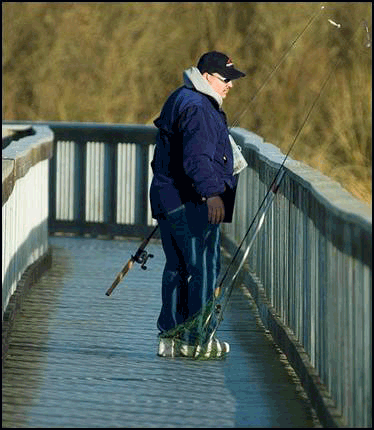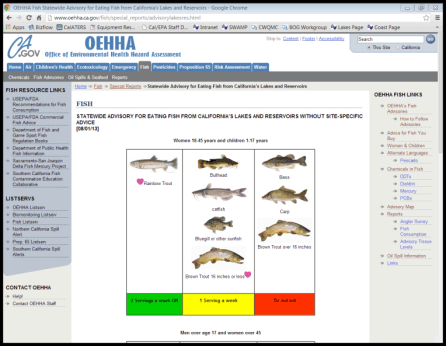SWAMP Lakes Study – Follow-up Monitoring
What is it?
A SWAMP-funded study conducted in 2007-08 found high levels of contaminants in fish at numerous lakes and reservoirs throughout California (Davis et. al. 2010.) This study was intended to be a “screening” study. It identified many lakes and reservoirs throughout the State with potentially serious contamination, but it did not collect enough fish to allow the development of detailed warnings or consumption advice. Follow-up monitoring is being conducted by the Regional Water Boards, using SWAMP funds, to provide sufficient data for the Cal-EPA’s Office of Environmental Health Hazard Assessment (OEHHA) to develop Safe Eating Guidelines for lakes and reservoirs where fish are contaminated.
Why is it important?
Contaminants in fish such as mercury and polychlorinated biphenyls (PCBs) can harm human health. PCBs can cause cancer. Mercury can harm the brain, especially in children. In order to protect human health, anglers need modern information about where and which species of fish are safe to eat. Before OEHHA can develop Safe Eating Guidelines for specific lakes and reservoirs, it needs more data. The follow-up monitoring being conducted by the Regional Water Boards is designed specifically to provide the data needed to characterize threats to human health, and to allow OEHHA to develop specific consumption advice.
How will this information be used?
OEHHA will use the data to develop Safe Eating Guidelines for specific lakes and reservoirs. The guidelines are produced in both narrative and easy-to-understand pictorial formats, and are often translated into multiple languages. The guidelines are posted at OEHHA’s website, at the Dept. of Fish and Wildlife’s website, and often distributed directly to anglers and/or posted on-site by lake managers.
The data will be made available to the public via the California Environmental Data Exchange Network (CEDEN).


Regional Water Quality Control Boards
- Region 2 – San Francisco Bay Region
- Region 3 – Central Coast Region
- Region 4 – Los Angeles Region
- Region 6 – Lahontan Region
Region 2 – San Francisco Bay Region
Completed during 2013: The SF Bay Water Board’s SWAMP sampled fish at three lakes in the East Bay Regional Parks District. The purpose of collecting this data was to refine fish consumption advisories that are in place (Lake Chabot) or to determine if they are warranted in lakes with no data. These lakes were Lake Temescal, Lake Chabot and Don Castro Reservoir. In addition, a fish consumption advisory was issued by the Office of Environmental Health Hazard Assessment (OEHHA) in November 2013 for Lake Vasona and Camden Ponds. The SF Bay Water Board’s SWAMP sampled this lake in 2010 because fish from this lake were shown to have high levels of PCBs in the statewide screening study.
OEHHA Advisories from this work:
- Camden Ponds (Santa Clara County), 2013
- Lake Vasona (Santa Clara County), 2013
2009
- Anderson Reservoir (Santa Clara County), 2009
- Bon Tempe Reservoir (Marin County), 2009
- Del Valle Reservoir (Alameda County), 2009
- Lafayette Reservoir (Contra Costa County), 2009
- Lake Chabot (Alameda County), 2009
- Lake Herman (Solano County), 2009
- Nicasio Reservoir (Marin County), 2009
- San Pablo Reservoir (Contra Costa County), 2009
- Soulajule Reservoir (Marin County), 2009
- Stevens Creek Reservoir (Santa Clara County), 2009
These advisories were due to high levels of mercury and/or PCBs. Several of these advisories were translated into multiple languages.
Region 3 – Central Coast Region
Completed during 2013: In the Central Coast Region, follow-up sampling has been conducted at seven lakes: Loch Lomond, Chesbro Reservoir, Uvas Reservoir, Pinto Lake, San Antonio Lake, Oso Flaco Lake and Santa Margarita Lake. Mercury was the primary concern at most of these lakes however, pesticide levels in fish tissue at Pinto and Oso Flaco lakes are also of concern. Additional monitoring at each of these lakes targeted additional species not analyzed in the statewide screening study. So far, OEHHA has developed a multiple species consumption advisory for Oso Falco Lake that includes pesticide information.
OEHHA Advisories from this work:
- Oso Flaco Lake (San Luis Obispo County), 2013
Region 4 – Los Angeles Region
Completed during 2013: In the Los Angeles Region, follow-up fish sampling was conducted at seven lakes and reservoirs. Fish were analyzed for mercury at all seven lakes/reservoirs (Lake Casitas, Lake Piru, Pyramid Lake, Castaic Lake, Puddingstone Reservoir, Santa Fe Reservoir and Hansen Lake). Fish also were analyzed for PCBs at Pyramid Lake.
OEHHA Advisories from this work:
- Pyramid Lake (Los Angeles County), 2013
Region 6 – Lahontan Region
Completed during 2014: OEHHA released Safe Eating Guidelines for Little Rock Reservoir (Los Angeles Co.) in March of 2014. The guidelines were translated into several languages and the Regional Water Board staff hosted and led a meeting to brief the county health department and reservoir operator about the advisory.
OEHHA Advisories from this work:
- Little Rock Reservoir (Los Angeles County), 2014
- Silverwood Lake (San Bernardino County), 2013
- Donner Lake (Nevada County), 2011


